"In ancient Athens, female hairstyle was a distinctive symbol of status worn by women of high social rank and affluence when they appeared in public settings such as religious festivals."
I've got the most wonderful thing to share with you today - it's a combination of art history, tradition, and merging today's students with reliving the historical past. The project? The Caryatid Hairstyling Project at Fairfield University, created by Dr. Katherine Schwab. In the Caryatid Project, the hairstyles of the six Caryatids from the Erechthion, on the Acropolis in Athens (some of my VERY favorite sculptures in the world), are re-created on students at Fairfield University. I viewed the dvd from the Caryatid Hairstyling Project, which is short but compelling. The students were so patient during the long hours of hairstyling, and many of them remarked how participating in this brought history alive to them. The hairstylist was an incredible artist, and it made me want to wear these classical hairstyles! They were so very beautiful and to imagine how old they were - and how styles can transcend time - brought home the timelessness of aspects of Greek art and culture. What an incredible way to learn - and experience - ancient art and culture.
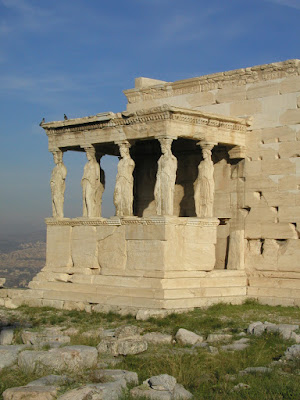
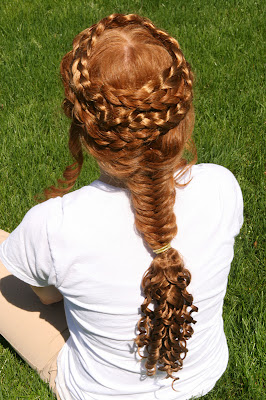
Dr. Schwab has her PhD from the Institute of Fine Arts, New York University. She has served as department chair at Fairfield University for two consecutive terms, and has served as Art History program director for several years. Her areas of expertise and interest encompass Greek and Roman Art and Archaeology, as well as South Asian and Asian Art.
As Curator of the Metropolitan Museum of Art Plaster Cast Collection at Fairfield University, Dr. Schwab oversees a growing cast collection of gifts and long-term renewable loans from the Metropolitan Museum of Art, as well as gifts from individual donors. With students she is preparing a selection of casts for installation in the Bellarmine Museum (Fall 2010).
Dr. Schwab's primary area of expertise is the Parthenon metopes, a component of the large sculptural program. Drawing and digital photography form a major part of her investigative tools. Her research, which is generously facilitated by the American School of Classical Studies at Athens, the First Ephorate of Prehistoric and Classical Antiquities, and the Ministry of Culture, in Greece, has yielded new information on the original appearance of the composition in the east and north metopes of the Parthenon. These results have been presented at conferences in the U.S., Europe, and Japan. She has made frequent research trips to Athens where the international community of archaeologists regularly meets. In addition, the study of Tibetan thangka painting with a master artist in the Western Himalayas has helped to refine her drawings of the Parthenon metopes.
We were lucky enough to catch Dr. Schwab in between trips to Greece, and talked about the Caryatid Project, the students, hair styles through the millenia, and more. Here's what she had to say...
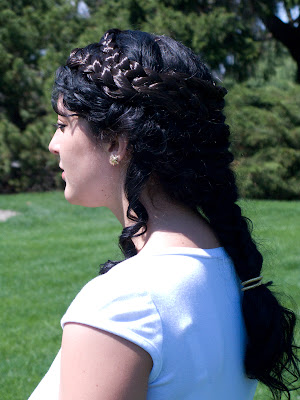
WE: Please tell us about the Caryatid Project...
KS: The project was an experiment to replicate the hairstyles of the famous Caryatids from the Erechtheion, now on view in the new Acropolis Museum. Our project webpage is located here, and you can learn more about the project, see samples of still photographs while the students’ hair is being transformed in the ancient hairstyles, bibliography and resources, and a link to watching a three-minute clip of the DVD as well as how to order the DVD. We hope that the project webpage will continue to evolve with more information and other short clips not included in the DVD. As a general resource, we hope the project will continually give students of any age a way to learn more about ancient Greece and specifically the Classical period through the topic of the Caryatid hairstyles. Many cultures around the world use hair (male or female) as a cultural marker, a way to signify who the individual is in society and phase in a lifetime. The Caryatids’ hairstyles are a remarkable and fascinating way to learn more about ancient Athenian society, especially during the fifth century B.C.

WE: What was the genesis of the Caryatid Project?
KS: In September 2007 Fairfield University hosted a beautiful photographic exhibition organized by the Benaki Museum. This exhibition, “The Creative Photograph in Archaeology,” explored the work of about eight photographers, from the invention of photography to the present, whose work changed how sites, buildings, monuments, and sculpture were photographed for the next generation. I was responsible for this exhibition coming to Fairfield and one of the things I did was organize a symposium to coincide with the opening of the exhibition. This level of involvement had me looking at the selected photographs even during the planning phases. Three photographs by Goesta Hellner (1970) of the Caryatids continually drew my attention. The exhibition included four other views of the Caryatids by Walter Hege (1928-29). I began noticing subtle but fascinating differences in the complexity of the hairstyles. A good friend here in Fairfield who often has her hair done in various ways for big events in NYC suggested that I have my hair styled like the Caryatids for the symposium and exhibition opening and she recommended a professional hair stylist who works at a salon in town. Please know that this is not at all typical for me. I brought copies of the photographs to the stylist and she was able to quickly determine the various braiding techniques and how this all came together. She did a practice session with my hair, a good trial and error run through, and then she knew exactly what to do with my hair on the big day. My hair is really not long enough or thick enough to carry off this hairstyle with any conviction, but the stylist made a lovely adaptation.
Students, especially female, were intrigued with my hairstyle on that occasion and I realized how recreating a particular ancient hairstyle might give students a way to connect with a past culture.
In early 2009 I applied for a research grant at Fairfield University. This awarded funding along with additional support from the Classical Studies Program made it possible to hire the stylist and film the styling session. I asked 7 students (one was an alternate who indeed was needed the day of filming) to be volunteer models because they had hair that was thick, long and in most cases wavy to curly. We stayed focused on the hair, because any attempt to replicate closely the clothing of the ancient statues would require a significant increase to the cost. By keeping it simple, and using a neutral palette, my hope was to let the styled hair be the focus and not clothing.

WE: Were you surprised by the end result - does time matter? These women look so timeless...Can hairstyles transcend time?
KS: The end result was remarkable to witness because the six hairstyles worn by the six student models were quite beautiful. The time frame for styling the hair and then photographing the students in the same arrangements as the original Caryatids took about seven hours. It was long, yet each student’s hair styling session was exciting. The culminating group photo session outdoors took place in front of Bellarmine Hall on a high elevation of the campus, with Long Island Sound in the background. Seeing the six models together in this arrangement and location was unexpectedly powerful. The hairstyles, especially seen from the back, were extraordinary because of the richness and variation.
The braiding techniques within the Caryatid hairstyles continue to be used today, but not all together. I would like to believe that as more women see these beautiful ancient Greek hairstyles they will seek out contemporary variations. Also, as more women rediscover the wavy and curly texture within their hair, they might be keen to explore creative ways of wearing their hair such as those adorning the Caryatids.
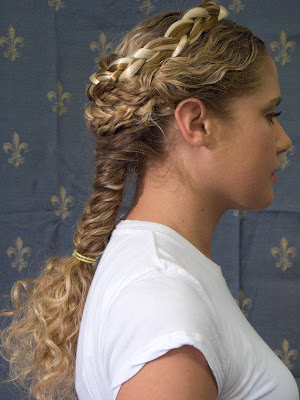
WE: How did the hairdresser know how to do this? What is her background, that she was able to do these?
KS: Milexy Torres, the hairstylist, was recommended to me because she has a reputation for developing complicated hairstyles. I made an appointment to meet with her and show her several photographs of the Caryatids’ hair taken by Goesta Hellner in the 1970s for the German Archaeological Institute in Athens. Milexy immediately recognized and described the various braiding techniques and said that she could replicate the hairstyles. We have to remember that a professional hairstylist will be much more familiar with the intricacies of hairstyles than someone whose specialization is art history or archaeology.
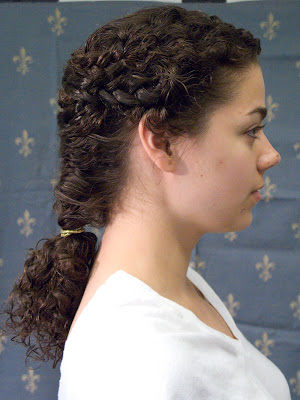
WE: What were the reactions of the students? Did working on this project make this time period come alive for them?
KS: It was fascinating to observe the students during the styling session. Some were used to having their hair styled for special events, whereas a few were experiencing something entirely new. All of the students had been very willing to volunteer their time for the styling session and final photographs. Their reactions began to change from individual curiosity to a larger awareness when we went outside and they stood in the original arrangement. The two students standing in the back, Kore A and Kore F, had the advantage of seeing the back view of the hairstyles worn by the front row (Kore B-E), and they commented at the time how remarkable the group view was. While the styling session took place on April 26, 2009, the student interviews in the DVD were recorded a few months later, which gave the students time to reflect on their experience. From both their interviews and subsequent email exchanges and conversations with me it is obviously how directly this project helped them make a connection with a specific monument as well as a time period and culture. Their understanding embraced the realization that these ancient Athenian hairstyles were not just about the particular style of hair but how these hairstyles were a reflection of young women and their place within a society. At least one of the students remarked in her interview about how the project brought the ancient time period to life.
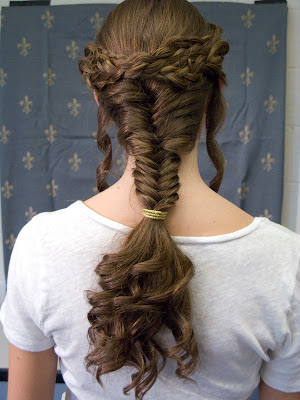
WE: When you researched ancient Greek hairstyles, what written sources did you find that explained the hairstyles of the day, or did you rely solely on the visual examples available?
KS: I relied on archival photographs spanning the 1920s-1970s, to carefully examine the hairstyles. Some of these photographs, such as those by Walter Hege and Goesta Hellner, are in the photographic collection of the German Archaeological Institute in Athens, and others are by Alison Frantz in the Alison Frantz Photographic Collection at the American School of Classical Studies at Athens (www.ascsa.edu.gr). The only ancient textual information I could find at the time was a brief mention of unguents used by men in their hair.
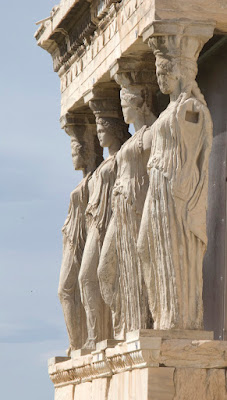
WE: In the video, you note that you had your own hair done. What did it feel like, to have your hair done in such a classic hairstyle? Did it lead to the project?
KS: Since I do not typically have my hair styled in any elaborate coiffure I really did not know what to expect. The trial run through felt a little strange, but when Milexy made the final version, an adaptation of the general hairstyle, it was extremely comfortable, very light and cool. I was surprised by how few pins and small plastic bands were needed to keep the different braids in place. The day I wore the hairstyle I received many comments from students and I began to realize that these hairstyles could be the basis for a collaborative research project.
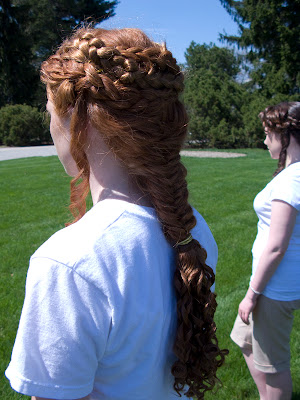
WE: Is there anything else you'd like to share with us?
KS: Once the press release was posted in early April, interest in the project and DVD has spread surprisingly far through the internet. The Athenian newspaper To Vima contacted the University for more information and photographs and their story on the project made the front page April 14. Classics departments have linked it to their Facebook page, and blog sites picked it up as well. My hope is that both our project page and the DVD will be increasingly useful for educational programs whether in schools and universities or through cultural organizations, particularly as a way to bring to life this monument of ancient Greek civilization and culture. Ultimately, the greatest reward is for viewers to travel to Athens. First, to see the Acropolis and the context of the Caryatid Porch as part of the Erechtheion, and second to visit the new Acropolis Museum where it is now possible to view the original Caryatids from every angle and to linger in observing the variations in the hairstyles, all of which can be seen from the back for the first time.
WE: Thanks so very much, Kathy! This project is inspiring and we highly recommend this project to our Wandering Educators - it's an excellent way to teach - and learn about - art, culture, and the timelessness of Greek art.
Individually, the Caryatids are referred to as a Kore (Kor-ree), which means maiden.
The Caryatids were originally the columns supporting the South Porch of the Erechtheion, a temple just to the north of the Parthenon, on the Athenian Acropolis.
Kore A - Sandra Cimino, '09
Kore B - Dana Westrup, '10
Kore C - Amber Nowak, '12
Kore D - Mara Giarratana Young, '11
Kore E - Caitlin Parker, '11
Kore F - Shannon Berger, '11
All photos courtesy and copyright The Caryatid Project
